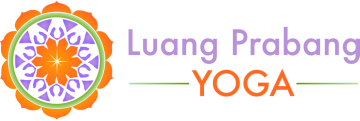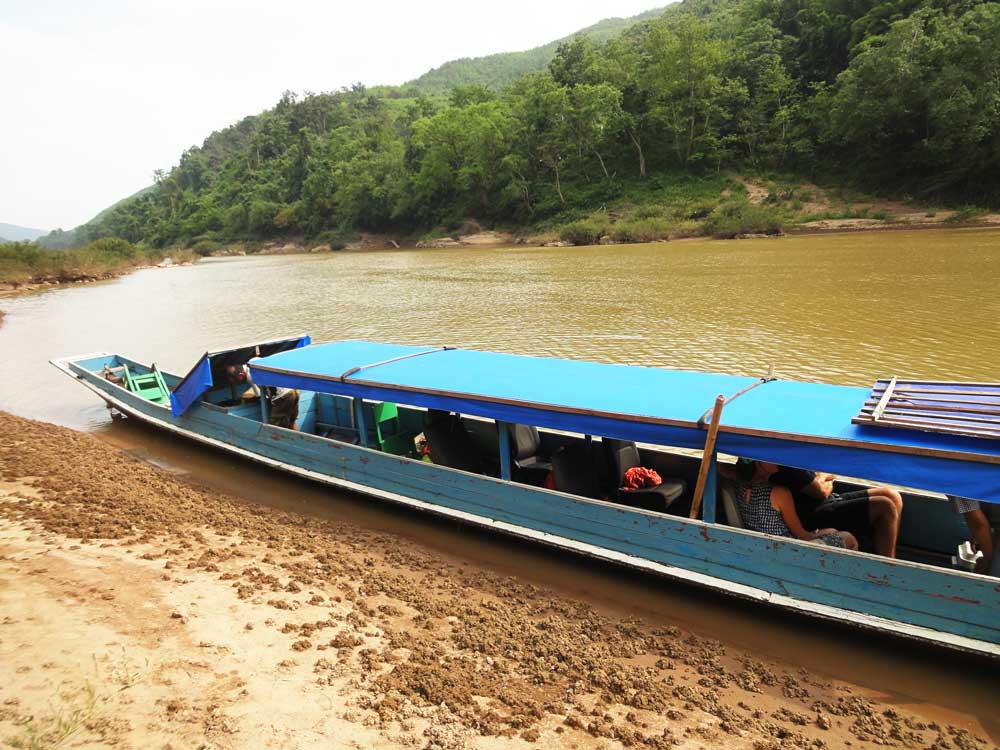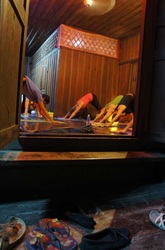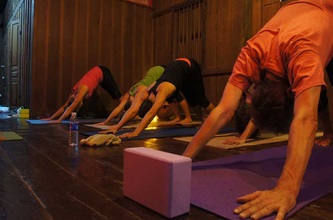 Here in Luang Prabang, we’re blessed with the kind of weather that allows us to practice yoga outside almost all year round. But practicing outdoors is not always easy. Most people are used to practicing indoors, in a quiet room, enclosed by walls that physically create the feeling of personal space. Outside, the weather, noise and insect life can often be distracting, but the joys of an outdoor practice far outweigh the cons. Here are ten reasons to practice outside while you’re in Luang Prabang and elsewhere, as well as some tips on how to make the most out of your outdoor yoga practice. 1. Where else can you practice with a picture perfect view of the Nam Khan and Mekong rivers? Most yoga studios are indoors, so most likely, a majority of your yoga classes have taken place inside. This makes sense considering most people live in cities that are not conducive to an outdoor practice either because the weather is not favorable or the environment, such as traffic and pollution, do not support a healthy practice. In Luang Prabang on the other hand, mountains, rivers, great weather and a slightly less modernized environment surround us. Yoga decks on the Nam Khan and Mekong rivers therefore can be used year round. Where else can you get this kind of view? 2. The ancient yogis drew their inspiration from nature. Practicing outdoors can help you connect more deeply to your yoga postures. Ancient yogis observed the natural environment in which they existed and understood how living things drew the energy of Mother Nature to survive and thrive. In modern day yoga asana practice, postures are often named after the natural elements that they represent. While practicing outdoors, draw inspiration in mountain pose from the mountains in the distance or root into the earth like the tree in front of you. Perhaps even experience gratitude for life as you salute the sun while it rises from the horizon. 3. Yoga is about non-duality. Feel oneness with the universe as you practice outside. In non-duality we remove the separation between the universe in which we exist and ourselves as individuals. This is a difficult concept to experience as modern society puts a high value on individuality, placing importance on the “Me,” “I” and “My.” Within the walls of a yoga studio, the focus is often on “my practice,” “my progress,” and “my space.” While there’s nothing fundamentally wrong with this, the experience of an outdoor practice can be eye opening. Outside we have less control over our environment and as such, the practice no longer becomes about “me.” It’s easier to realize our tiny significance and insignificance in the larger scheme of the universe as rivers flow, birds fly and insects buzz around, each with their own role to play, without concern or care that we’re out there in the middle of our yoga practice. 4. Have you ever seen the full moon rising behind the mountains and light up the river in front of you as you awake under a starry sky from Savasana? During the winter months in Luang Prabang, the full moon rises above the Nam Khan River, usually at the end of the sunset yoga class, as yogis make their way towards or out of Savasana. The yoga deck is lit with candles. There’s not much else to say about this one. 5. Peace comes from within. There’s a misconception that an enclosed room will protect you from noise. Perhaps if the building were soundproof this would be true. The reality is however, that most are not. Even within the confines of walls, you can hear the rumbling of motorcycles outside, the sound of construction equipment from the house next door or the clatter from the neighbor’s kitchen. Walls often create the illusion of quiet, but true peace comes from within. Practicing outdoors encourages us to quickly look inside ourselves as we cannot always rely on our environment to create the feeling of calm. 6. We naturally feel happier outside, in the sun. It’s common knowledge that catching some sun each day helps to boost serotonin levels and makes us happier people. Maybe it’s a combination of the view, the sun and the yoga, but yogis coming off a practice on our outdoor deck definitely look like they’ve had a dose of the happy pill. If that isn’t a reason to practice outside, I don’t know what is. 7. Problems with mosquitos? There’s nothing a little mosquito spray can’t fix. Mosquitos and other insects appear to be the number one reason why people don’t want to practice outside. During the rainy season here in Laos, mosquitos can be more of a nuisance than in the dry, winter months, but that’s not something a little mosquito spray can’t fix. If you’re considering practicing outdoors regularly and are concerned about too much use of Deet, natural insect repellents are just as effective. They need to be reapplied every 3 hours instead of the usual 7 hours required for sprays that contain Deet, but that’s enough for a 90-minute yoga session. 8. Learning to deal with unexpected situations is a step towards living life happily. It’s true that it’s a lot harder to control the environment when practicing outdoors. From unpredictable weather, to people chatting, to interruptions from insects and animals, there are a lot of factors beyond our control. But isn’t it also true too that unpredictability is a fact of life? Learning how to navigate unforeseen situations without letting them affect us is key to living a happy life. Next time something happens that’s not within your control, observe how you react to it. Through an outdoor practice, you can hone the ability to let the little things slide with indifference. Does it really matter if someone accidentally walks into your personal space? Was it really “your” space to being with? 9. Experience freedom by practicing outdoors. Ah freedom! It’s something we strive for, yet most of us don’t really know what it feels like. Practicing yoga outdoors can help us experience freedom in a way that cannot be easily replicated indoors. The expanse of the sky above can give us a sense of freedom as it takes us away from the enclosed environments that we are usually confined within (house, office, car etc.). Outside, space is limitless. We connect to this limitless space as we extend upwards from our heels to the crown of our heads and from fingertip to fingertip as we spread our arms like wings into the vastness of the outdoors. 10. If you can practice outside, you can practice anywhere, anytime. If you build the ability to practice outdoors, you can pretty much guarantee that you can take your yoga practice anywhere. All you have to do is find a flat surface, close your eyes, look within, and the perfect yoga space can be created. Blog post by Julie (juliehana.com)
0 Comments
 There are good yoga teachers, and then there are great yoga teachers. The good teachers challenge us. Physically, they help us push the limits of our capabilities. Mentally and emotionally, they impart confidence, self-worth and discipline. The great teachers however, touch our souls in a way that causes a vital shift to our inner being, leaving us a little bit transformed. In this lifetime, we will likely only encounter a handful of these great teachers. We may not recognize them upon first meeting them. Most probably, we would not have heard of them before. Teachers like these do not seek fame. Rather, they practice and teach, touching one person at a time, without the need for recognition and without the need to be commended. In the end, it is not their goal either to instill these changes in others. Those who come with an open heart and mind will gain the benefit of their teachings. Those that are closed to it will not. They don’t tell us what we should or should not do or think. They do not judge us for how we live our lives. Most importantly, great teachers grow in us, the desire to be better people, to be selfless people. In a single class, these teachers can make you feel your smallness in the larger scheme of the universe, yet feel so connected to it at the same time; to want to sacrifice your own goals for those of humanity; to feel deeply for all of humanity; to have compassion for all things good and bad; to love and to truly seek peace. To all the inspirational teachers out there, THANK YOU! Blog post by Julie (juliehana.com) I’m a yoga teacher, not a cyclist by any standards. In fact, until two weeks ago I had never really enjoyed cycling much. The most I had cycled in recent years was a basic commute to and from the different places where I teach yoga around Luang Prabang. When Virginia from SoulFit Adventures contacted me to ask whether I’d like to join her as a yoga teacher on the next trip around Northern Laos, I certainly had a few concerns. I might have been inclined to turn the offer down had I not gone to bed a month earlier with a plea to the universe to have someone invite me to teach on their retreat. As it turns out, the universe was listening. But a cycling retreat? I took it as a sign – the universe telling me to once again do something I never thought I would. I’ve lived in Laos for over a year and traveled a fair bit through the country. The mountain roads would be no easy feat. Now, a week after the completion of the journey, I’m in awe at what the human mind and body is capable of, I’ve fallen in love all over again with the country I’ve chosen to live in, and feel more connected to the people who call it home. For until you can appreciate every uphill and downhill through the experience of your own physical effort and mental will, you cannot truly appreciate the lives of the people who live each day in the villages scattered throughout. The SoulFit Adventures’ “Cycling for the Soul in Northern Laos” trip is not just about cycling however. It’s a high-end retreat that takes you not only through stunning countryside, but also to some pretty upmarket establishments. Massages included throughout the trip and unlimited yoga ensures a quick recovery for tired muscles. Oh and did I mention the food? Local street food and gourmet gastronomy provided us with much-needed energy. Our local guide Saylom made sure we were always fully stocked with a delicious assortment of fruit for our regular breaks along the road. Off course, for me, teaching and practicing yoga in some of the most beautiful locations was a highlight. From yoga decks overlooking the Namkhan River to awe-inspiring Mekong yoga experiences, I really felt my smallness in the bigger scheme of things. As many yoga postures draw their inspiration from nature, practicing in beautiful and natural surroundings really helps to build a sense of connection to world in which we live. Whether you’re a yogi, cyclist, foodie or adventure junkie, the SoulFit Adventures retreat in Laos has something for you. I guarantee you’ll discover something new and perhaps you’ll even walk away a little bit transformed. Here’s a photo album of some of the highlights of the May 2013 trip. The next trip leaves on October 15. Contact Virginia for more information Virginia@soulfitadventures.com Luang Prabang to Nong Khiaw - 70km Cycling Day Boat Ride from Nong Khiaw to Mueng Khua Mueng Khua to Muang La - 73km Cycling Day Muang La - Oudomxay - Pak Beng Boat Ride from Pak Beng to Pak Ou and Our Return to Luang Prabang Blog Post by Julie (juliehana.com)
 Let’s face it people, yoga injuries do happen! And, they’re on the rise. In 2007, the U.S. Consumer Product Safety Commission (CPSC) reported 5,500 yoga-related injuries that were treated in emergency rooms or doctors’ offices. In 2010, that number increased to 7,369. Whether the growth of reported injuries is a result of more people taking up yoga or because we’re finally admitting to it, the fact is, they are happening. Moreover, these figures are probably also understated as there’s still reluctance amongst many in the yoga community to concede to the notion that yoga can do harm. Now wait a minute! I’m a yoga teacher, so why am I telling you this? I should be telling you about all the positive things that come with developing a regular yoga practice right? Well, I’m about to do that too. But the important lesson here is that, just like other physically challenging activities, you can hurt yourself. Accepting this is the first step in injury prevention. Yoga used to be viewed by many as a practice that could do no harm, so people practiced as if this were true. We now know this view to be incorrect. Approaching your yoga practice with awareness of your body and awareness how the practice relates to your own body is essential. So now, the good stuff. I’m off course a strong proponent of yoga. I’ve practiced for 10 years now and seen my body transform over the years. I’ve managed chronic knee and back pain through yoga and even kept my lymphangioma, a malformation of the lymphatic system, under control. Yoga has been known to relieve medical conditions from arthritis, to auto-immune diseases such as multiple sclerosis. From a mental and emotional perspective, it helps us to sweat the small stuff less. But all this would be for nothing if we don’t learn to keep our yoga practice safe.  I know it sounds cliché, but ultimately, the ego is the number one cause of yoga injuries. It’s not just the ego of the student that can be harmful, but that of the teacher as well. To quote an article by Sura in the Huffington Post (The Dark Side of Yoga): “The way people approach life is the way people show up on their yoga mat. And yoga teachers are no exception. Some yoga teachers may lead with a sense of aggression and competition while others will promote a feeling of safety and peace.” While yoga is a practice that’s supposed to help us let go of our ego, the reality is that we are ego-full beings. It’s not uncommon for the ego to be unleashed before it is diminished. For students, this may mean forcing ourselves into a posture that our bodies may not be ready for. For teachers, it may mean telling students to come to class despite their injuries, just to keep attendance high. Both are incredibly dangerous. It’s also not uncommon in class to hear the teacher say things like “breathe through the pain” and “work around your edge.” I’m not a fan of the “one size fits all” approach and find that phrases such as these can be incredibly harmful. For someone that’s more sluggish, lacks energy and harder to motivate, encouragement to work around his or her edge can be safe enough. However, for the competitive, high-energy, driven person, these words may be the extra half centimeter in hanumanasana (forward split) that leads to a torn hamstring, the straight legs that leads to an injured lower back, or the extra 3 breaths in sirsasana (headstand) that causes the neck and shoulder injury. Furthermore, teachers need to feel ok to tell their students to stop their yoga practice until they consult a physician, especially when the teacher is not well informed about the student’s condition. And certainly there’s nothing wrong with saying, “I don’t know, but let me consult a senior teacher or yoga therapist and get back to you. In the meantime, avoid this posture/practice until I find out more.” Yoga can be an incredibly beneficial practice to all, but it’s up to each individual, whether student or teacher to ensure the practice remains safe and sustainable. Blog post by Julie (juliehana.com)  When it comes to modern-day yoga, there are certainly enough styles out there to spin your head around in circles. From the more traditional Ashtanga and Iyengar practices, yoga has sprung into a myriad of branches as a result of branding in a competitive market. Amongst the different styles of yoga, Vinyasa Flow has emerged with increasing popularity in recent years. But Vinyasa Flow itself covers such diverse practices that it can also be divided into subcategories ranging from the more basic “Gentle Flow” to the more dynamic, Ashtanga-inspired “Power Yoga.” As a Vinyasa Yoga teacher however, the true meaning of Vinyasa Flow, to me, lies less in definition of the “style” and more in the “intention” of the practice and the lessons learned through movement. The word “Vinyasa” refers to: (1) The synchronization of breath and movement and (2) an intelligent sequencing of postures linked to create a continuous flow. Whether gentle or dynamic, Vinyasa Flow classes are typically marked by a smooth transition from one posture to the next. For students and teachers with an appreciation for individuality and aversion to rigidity, the practice permits creative freedom. While Vinyasa Flow has its roots in the more structured Ashtanga Yoga, today the practice has absorbed pieces of many different styles and Vinyasa teachers borrow liberally from the world around them.  At its core, Vinyasa Flow is about experiencing life. Through the continuous flow of movement, we are reminded of the impermanence of everything but change. Because there is no pre-defined sequence in Vinyasa Flow, classes are unpredictable, encouraging students to leave behind their expectations. There’s a lesson of acceptance in the flow as we are reminded to receive pleasure and pain, joy and sadness, triumphs and falls equally. The practice of Vinyasa Flow emphasizes the process rather than the end goal, so rather than measuring progress by proficiency in a posture, students are told to observe their own reactions, be it frustration, determination, anger, obsession or enjoyment. It’s the knowledge gained of oneself in the journey towards the posture that is the ultimate lesson here. In the end, Vinyasa Flow is about finding joy in movement as well as joy in life. It’s about being open and adventurous and stepping out of the box. Sometimes, it’s about breaking rules and redefining what you see in front of you. Developing a personal Vinyasa Flow practice at home can also help you to connect with yourself. It’s a great exercise in learning how to give yourself exactly what you need and having fun at the same time. Remember, try not to take yourself or your practice too seriously. Stay lighthearted and enjoy the ride. Blog post by Julie (juliehana.com)  I was inspired to write this post about yoga and gender issues after a fellow yoga teacher posted this photograph on Facebook earlier this week. This photograph raises so many thoughts and questions. Why has yoga been stereotyped as a female form of exercise in the west? Why do so many men resist it when a lot of the strength and balancing postures favor the male body? What can we learn about practicing and teaching yoga so that it is relevant and safe for both genders? I’d like to start by introducing a little bit of yoga history that many people may not be aware of. While the traditional practice of yoga philosophy and meditation are thousands of years old, modern postural yoga asana as commonly seen in the west was developed at the end of the 19th century and early 20th century. Prior to this, the practice of asana was subordinate and in some cases even rejected by traditional yoga teachers who put precedence on pranayama (breath technique) and meditation. One of the most influential figures in the development of modern yoga asana is T. Krishnamacharya, who was commissioned by the Maharaja of Mysore to create a dynamic physical practice for India’s youth. What resulted is yoga asana as we know today, which is a combination of hatha yoga, wrestling exercises, and modern Western gymnastics (for a more detailed account of yoga history, go to http://www.yogajournal.com/wisdom/2610). In the early years, the practice of yoga was developed by men, taught by men and practiced only by men. In fact, Indra Devi, who is also known as the “Mother of Western Yoga,” was refused instruction by Krishnamacharya on the basis that she was Western and a woman. It took the convincing of the Maharaja of Mysore and a lot of hard work for Indra Devi to finally be accepted and respected within the yoga community. So this begs the question, with a strong lineage of male founders, when and how did women become the main practitioners of yoga? It’s perhaps due to strong female figures like Indra Devi as well as more recent teachers who have transformed the practice of yoga from “the male-centered, rigid style with a distinctly feminine practice that honors intuition, family, flow, connection, community, activism, and the cyclical nature of women’s lives” (from the official website of the movie Yoga Woman). With the increased popularity of yoga in the 1960s, more and more women were drawn to the practice until today, over 70% of yoga practitioners are women. Perhaps it is intimidating for a man to walk into a room full of women, as is common in most yoga studios. Perhaps, because men tend to be more athletic or drawn towards strength training, they’re also naturally tighter and less flexible, which can make a yoga practice incredibly painful, especially where hip and shoulder openers are concerned. Perhaps it has to do with ego, where men feel they have to do better than women. Whatever the reason, yoga has transformed. In an attempt to attract more men, many studios have started offering specialized classes, tailored specifically for the male body. Think of Broga®, Yoga for Men. The homepage of the Broga® website reads: “Men think differently, and their bodies move differently than women’s. Shouldn’t there be a yoga class geared specifically for the bodies and minds of men? Actually, there is, and it’s called Broga® Yoga.” The irony in this is while women comprise the majority of students, many of the basic yoga postures are still more male friendly. Take Chatarunga Dandasana, for example. It is a posture that is done over and over again in the Ashtanga and Vinyasa styles of yoga. Men tend to have much more upper body strength then women and can use the strength of their pectoral muscles to take them through the posture. If practiced incorrectly in the long term, this posture can be harmful on the shoulders and wrists, making women more susceptible to injury in this posture. The distance between a man’s hips and his floating ribs is a fraction of the distance for a woman. Therefore, women can be much more “bendy,” but more susceptible again to injury, whereas men have the structural stability of the shorter hip to rib distance. Arm balances such as Bakasana and Eka Pada Koundiyasana present more challenges to women since a woman’s center of gravity is on average one inch lower and further back than a man's. She also carries more weight below the waist; around her hips, buttocks, and thighs. The point of this blog is not to argue over who struggles more in yoga, and who has it easier, but to present the challenges faced by both genders. As practitioners it’s important to be aware of our own anatomical challenges so that we can practice in a way that is safe and sustainable. As teachers, it is critical to understand the anatomical differences between men and women so that we can teach in a way that is safe for everyone in the class, and so that we can be understanding and empathize with the struggles faced by the opposite gender. Yoga’s a practice that will benefit all, no matter what size and shape you are. Traditionally, it was taught one-on-one from teacher to student. In today’s world of packed out yoga classes, the one-size fits all approach has left many (not just men) alienated to the practice. From a personal level, understanding your own body and your physical structure will help you to observe, accept and appreciate your yoga practice exactly where it is instead of worrying about where you think it should be. I invite you to make any comments, arguments or even corrections to anything that I have written in this post. They reflect my own personal opinions and not those of Luang Prabang Yoga. Blog post by Julie (juliehana.com)  Shiva is one of the three main Gods in the Hindu Pantheon; he is the God of destruction and transformation. Shiva is also the God of Yoga, as the goal of Yoga is transformation; transformation of our bodies into healthy, flexible, strong temples for our soul and mind, and transformation of our „monkey mind“ into a peaceful, stable, relaxed and joyful state, allowing us to perceive life as a beautiful, growing and flowing ride despite of all challenges and ongoing changes. So what can we do to achieve this? Of course, Practice Yoga... :-) But what does that mean? Most commonly when we talk about Yoga, we think of practicing Asanas (Yoga postures) and maybe doing some breathing (Pranayama) along with it. And thats fine as a good Asana session can already leave us feeling more relaxed, more balanced and connected to ourself and others. But gaining this stability in ourself through the Asana practice is only one of the paths of Yoga. There are three additional paths to reach the same goal. Karma Yoga (selfless service), Jnana Yoga (studying of spiritual scriptures) and Bhakti Yoga (devotional service). Depending on our own personality or life circumstances one may work better for us than the other. An important part of Bhakti Yoga is the repeating or chanting of „Mantras“. Loosely translated, Mantra means: „protection of the mind against negative thoughts/forces“. Mostly we try to protect our house, our money, our children against negative influences, but what about our mind? Is our own mind sometimes not the most harmful and our worst enemy? Chanting a „Mantra“ can help us attain peace of heart and mind by cultivating the positive qualities represented by a specific Hindu deity. As mentioned, Shiva is the God of destruction and transformation. By chanting his mantra OM NAMAH SHIVAYA we literally try to build and cultivate in ourself the power to destroy our negative thoughts like greed, anger, jealousy and to transform them into postive ones like tolerance, humility, compassion etc. which we then have to cultivate and carry in our heart in order to bring our inner light to shine. Only when we „destroy“ first, i.e. when we let go and make space, we have room to fill our cup again. Clarity of the mind opens our third eye, our eye of Intuition. NAMAH and also NAMAS means prostrating or bowing (the English word „name“ has its roots here). OM NAHMAH means „to bow in the presence of Om“, i.e. „in the presence of the primordial sound“; thus OM NAMAH SHIVAYA may loosely be translated as „in the presence of the primordial sound I bow to you Shiva“. In the Yoga tradition using mantras or chanting is the royal path to transforming our mind as it works over emotions and thus touches the very essence of our being. So perhaps you may want to give it a try, see what a bit of meditation and listening to or even singing this mantra may do for you. Be open, be surprised.... J check out the video below: blogpost by Kathrin  I’ve been practicing yoga for about 10 years now. For the first 8 years, you can say that I was pretty much obsessed with the power Vinyasa style. More recently however, I’ve begun to dabble in various different styles of yoga including, but not limited to Iyengar, Sivananda Hatha Yoga, Jivamukti, Vini Yoga, Yin Yoga and Anusara. Some may say that being involved in the different styles and different philosophies waters down my commitment to each, but I disagree. Students come to my classes from different backgrounds and practices. I want to understand where they come from and what they practice. I love incorporating aspects of the different philosophies into my teachings because I believe there’s truth in all of them. That’s why, when Yuri approached me last week to ask whether he could teach a Kundalini Yoga class, I jumped at the opportunity to again expand my knowledge and understanding of yet another yoga perspective. Of all the yoga styles and philosophies that I’ve encountered, Kundalini Yoga has always peaked my curiosity. It’s quite different from the Hatha and Ashtanga yoga lineage. I’ve also heard the claim that one Kundalini class is something like ten times more effective than other forms of yoga in stimulating change in a person’s life. So yesterday morning, I went to find out for myself. Before I get into the specifics of the practice, I’d like to clear up one minor detail – one that tends to confuse people. As the goal of all yoga practices is the union of the Shiva and Shakti aspects, representing consciousness and creation, which is triggered by the awakening of Kundalini energy, a dormant potential force that lies at the base of the spine, all yoga is essentially Kundalini yoga. However, in this case, I’m referring to the “Kundalini Yoga as taught by Yogi Bhajan,” who brought the practice to the west in the late 1960s. Now, to the practice. We began with a short meditation while repeating the mantra “Ong Namo Guru Dev Namo” to open the heart and empower us through our practice. Then began a series of short repetitive movements accompanied by the “breath of fire,” which is a little bit like controlled hyperventilation. I found the movements to be similar to some of the Vini Yoga movements that I’ve practiced before, but much faster. A simple example of one of these movements is taking your fingers to the shoulders with the elbows lifted to shoulder height. Inhale as you turn the entire torso, head and neck to the left. Exhale as you turn to the right. Now repeat this fast while using the breath of fire for about a minute and a half. Try it. It’s a lot harder than it seems, but somewhere between the burning shoulders, the focus on the area of the third eye and the breath of fire, I felt energy being released inside my body. Okay, maybe it was the light-headedness that resulted from the hyperventilation, but through the movements and breathing and focus, I experienced a complete release of all the tension that I’d been holding on to all week. I shrugged it out through my shoulders, chopped down my obstacles with an invisible sword, released my fears through my breath and let all the worries escape by focusing on the light between my eyes. When it was all done, I laid down in Savasana and let the emptiness sweep over me. I won’t vouch that everyone who attended class yesterday morning felt like this, although I’ll bet there are at least a couple of sore shoulders out there. Do I think I’ll be enlightened ten times faster? I’m not sure, but I do know that this certainly will not be my last Kundalini Yoga class. I’d like to thank Yuri for teaching such a great class! Blog post by Julie (juliehana.com)  Jessica Magnin began her workshop last weekend by asking, “How many people made a new year’s resolution this year?” Out of a room full of 20 people, only four raised their hands. Then came the question, “For those who did not make one, why didn’t you?” The answer, for most, was simple. New year’s resolutions almost always fail. And there you have it, the word “FAIL” or “FAILURE.” Jessica explained that more often than not, the resolutions that we make are coupled with the potential to fail. Furthermore, resolutions such as “I will quit smoking this year” or “I will go to the gym four times a week” are created as a result of what we think we “should” be doing. A dictionary defines “should” as “used to indicate obligation, duty or correctness, typically when criticizing someone’s actions.” Thus in creating many of our resolutions, we’re engaging in a cycle of self-criticism, which leads to failure when the resolution is not fulfilled, which again leads to even more self-criticism.  What if we were to change the way we made our resolutions? According to Jessica, choosing the right words and the right intention is key. So let’s start at the top and instead of “creating a resolution” let’s call it “seeding our intentions.” Right there, we generate an image of new beginnings, of growth and of continuous change. We switch from what our brains think we “should” do to what our hearts feel we “want” to do. In choosing the words of your intention or Sankalpa, keep to larger and more general concepts such as happiness, peace or health rather than specific material desires such as money, career or body weight. Write down a few words or phrases, and then perhaps even a sentence using these words and phrases. When writing the sentence, be sure to begin the sentence with “I have” or “I am” rather than “I want” or “I must” so it becomes something positive that you are already experiencing.  It’s a simple process really, but the result is empowering. Repeat your Sankalpa to yourself three times and let it resonate from the depths of your heart. Feel it taking place already. Take this further by combining a yoga practice focused on back-bending to open the heart and the throat where anahata chakra and vishuddhi chakra are respectively located, manifesting thoughts and speech into reality. With the creation of the proper intention, seeded from the right words and right purpose, feel the connection to your true self or the nature of goodness within yourself that is unaffected by outside factors. Add twisting postures to your practice to illuminate your spine and remember, “the light within you is the same light that illuminates the entire universe.” Thank you Jessica for your teachings and thanks to all the participants who showed up to support the SMILE Project. Blog post by Julie (juliehana.com) In December 2012 Al Jazeera producer and Huffington Post journalist, Bhanu Bhatnagar, completed his yoga teacher training and taught his first yoga class at the practice space in Ban Aphai. In line with the yoga community’s commitment to Karma Yoga, or service, the class was held as a fundraiser for the Traditional Arts and Ethnology Center (TAEC). Proceeds of the class that was held on December 10 went towards supporting TAEC’s mission of preserving cultural diversity in Laos.
Bhanu recently wrote about his first teaching experience in the Huffington Post. The article is a reflection on an experience that most yoga teachers can appreciate. For students, this is a great insight into some of the challenges that your teachers face as they strive to deliver guidance, knowledge and compassion in their classes. Read the Huffington Post article. The following photographs were taken by Casey Conroy. |
Archives
September 2023
Categories
All
|





































 RSS Feed
RSS Feed
